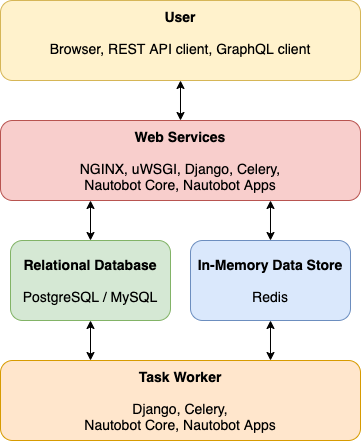Please install only when CI is PASSING!
This role installs Nautobot as a Docker container on Ubuntu, with Docker installed via the bsmeding.docker role. For a full setup, use bsmeding.docker for Docker installation, followed by bsmeding.nautobot_docker for Nautobot.
Nautobot is a network CMDB tool, originally a fork of NetBox, tailored for network automation. It serves as a single source of truth, enhancing network management and automation.
Overview of the Nautobot application stack:
- Install pip requirements on the Ansible host:
pip install -r requirements.txt
Add the following roles to your requirements.yml file:
roles:
- name: bsmeding.docker
- name: bsmeding.nautobot_dockerInstall these roles with:
ansible-galaxy install -r requirements.yml---
- name: Install Nautobot
hosts: [nautobot]
gather_facts: true
become: yes
tasks:
- name: Check if Docker is installed
include_role:
name: bsmeding.docker
- name: Check if Nautobot is installed
include_role:
name: bsmeding.nautobot_dockerAfter successful installation, Nautobot will run on port
8080by default, with login credentialsadmin/admin.
Below are key variables for customizing the Nautobot Docker installation. These variables can be added to your playbook or a separate variable file.
-
container_time_zone: Sets the timezone inside the container.- Default:
'Europe/Amsterdam'
- Default:
-
nautobot__name: Defines the name of the Nautobot Docker container.- Default:
'nautobot'
- Default:
-
nautobot__image: Specifies the Docker image for Nautobot.- Default:
'nautobot:2.3'
- Default:
-
nautobot__image_python_version: Python version to be used in the container.- Default:
'3.9'
- Default:
-
nautobot__install_ansible_version: The Ansible version to install in the container.- Default:
'8.2.0'
- Default:
-
nautobot__install_ansible_collections: List of Ansible collections to install in the container.- Default:
['ansible.netcommon', 'ansible.utils']
- Default:
-
nautobot__pip_install_extra_args: Extra arguments forpipinstallations, useful for skipping SSL checks or using a custom PIP server.
-
nautobot__port_http: The HTTP port Nautobot will run on.- Default:
8080
- Default:
-
nautobot__port_https: The HTTPS port Nautobot will run on if enabled.- Default:
8444
- Default:
-
nautobot__allowed_hosts: Specifies which hosts are allowed to access Nautobot.- Default:
'*'
- Default:
-
nautobot__home: Directory path where Nautobot is installed in the container.- Default:
"/opt/{{ nautobot__name }}"
- Default:
-
nautobot__number_of_workers: Sets the number of worker processes for handling requests.- Default:
1
- Default:
-
nautobot__pause_before_start_worker: Time in seconds to pause before starting workers, useful in migrations.- Default:
0
- Default:
-
nautobot__remove_existing_container: Whether to remove an existing container on redeployment.- Default:
false
- Default:
-
nautobot__pull_image: Whether to pull the latest Docker image on deployment.- Default:
true
- Default:
-
nautobot__container_uid: User ID for the Nautobot container.- Default:
999
- Default:
-
nautobot__container_gid: Group ID for the Nautobot container.- Default:
998
- Default:
-
nautobot__directories: List of directories to create with specific permissions.- Example:
nautobot__directories: - path: "/opt/nautobot" mode: "0760" owner: "{{ nautobot__container_uid }}" group: "{{ nautobot__container_gid }}"
- Example:
Important: Change these values in production environments.
-
nautobot__superuser_name: Username for the default superuser.- Default:
'admin'
- Default:
-
nautobot__superuser_password: Password for the default superuser.- Default:
'admin'
- Default:
-
nautobot__superuser_api_token: API token for the superuser, must be 40 characters or fewer.- Example:
"1234567890abcdefghijklmnopqrstuvwxyz0987"
- Example:
To install plugins, set the nautobot__plugins variable with plugin configurations. Example:
nautobot__plugins:
- plugin_name: nautobot_device_onboarding
plugin_config: {
"nautobot_device_onboarding": {
"default_ip_status": "Active",
"default_device_role": "onboarding",
}
}
- plugin_name: nautobot-golden-config
plugin_config: {
"nautobot_golden_config": {
"enable_intended": True,
"sot_agg_transposer": None,
}
}Add GraphQL queries so that the variables can be retreived in the Jinja templating (Extensibility -> GraphQL Queries)
Examplje GraphQL
query ($device_id: ID!) {
device(id: $device_id) {
config_context
hostname: name
position
serial
primary_ip4 {
id
primary_ip4_for {
id
name
}
}
tenant {
name
}
tags {
name
slug
}
device_role {
name
}
platform {
name
slug
manufacturer {
name
}
napalm_driver
}
site {
name
slug
vlans {
id
name
vid
}
vlan_groups {
id
}
}
interfaces {
description
mac_address
enabled
name
ip_addresses {
address
tags {
id
}
}
connected_circuit_termination {
circuit {
cid
commit_rate
provider {
name
}
}
}
tagged_vlans {
id
}
untagged_vlan {
id
}
cable {
termination_a_type
status {
name
}
color
}
tagged_vlans {
site {
name
}
id
}
tags {
id
}
}
}
}
nautobot__extra_pip_packages: Add additional Python packages needed in the container.nautobot__extra_os_packages: Add extra OS packages as necessary.
If migrating from Nautobot v1 to v2, set nautobot__pause_before_start_worker to at least 600 seconds to allow the database to migrate before starting workers.
If the stack doesn’t start after a hard shutdown (e.g., due to Redis corruption), you might see an error message about the appendonly.aof file. Use the following command to fix this issue:
sudo redis-check-aof --fix appendonly.aofFor additional troubleshooting, check the Docker logs and inspect paths with docker inspect nautobot-redis.
By following this guide, you’ll have a fully configured Nautobot deployment in Docker using Ansible.

